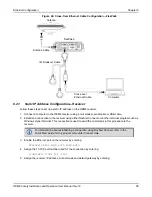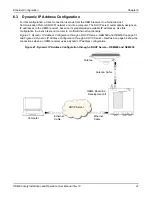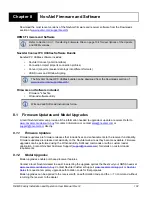
Ethernet Configuration
Chapter 6
OEM6 Family Installation and Operation User Manual Rev 12
95
2. Establish a connection to the receiver using either NovAtel Connect or another terminal program such as
Windows HyperTerminal. This connection is used to send the commands in this procedure to the
receivers.
3. Connect the power cables to both of the OEM6 receivers and apply power to the receivers.
4. Connect the Ethernet cables to the Ethernet ports on both OEM6 receivers.
5. Establish an Ethernet connection, either static or dynamic configurations. Refer to
on page 87 or
Section 6.3, Dynamic IP Address Configuration
more information.
6. Send the following commands to each receiver either through serial or USB ports:
Base
:
FIX POSITION <lat> <long> <height>
INTERFACEMODE ICOM1 NONE RTCA off
LOG ICOM1 RTCAOBS2 ONTIME 1
LOG ICOM1 RTCAREF ONTIME 10
LOG ICOM1 RTCA1 ONTIME 5
SAVECONFIG
Rover
:
ICOMCONFIG ICOM1 TCP <base ip address>:<base port #>
INTERFACEMODE ICOM1 RTCA NONE OFF
LOG BESTPOSA ONTIME 1 (optional)
SAVECONFIG
Use the BESTPOS log to confirm that the OEM6 rover is in RTK mode.
6.5
Large COM Port Data Throughput
For high data rate Ethernet logging using TCP/IP, disable Windows Delayed Ack Algorithm (DAA) for
complete data logging. If you do not disable DAA, there will be data gaps due to the Windows Ethernet buffer.
Windows XP (SP3) and Windows Server 2003:
http://support.microsoft.com/kb/328890
http://support.microsoft.com/kb/815230
For information about establishing a connection using NovAtel Connect, refer to the
Quick Start Guide for the product or NovAtel Connect Help.
If done incorrectly, changing the Windows Registry may impair the operation of the
computer. Editing the Windows Registry is for advanced Microsoft Windows users
only. NovAtel Inc. is not able to provide any technical support for any actions taken
regarding information found in Microsoft’s Knowledge Base.






























